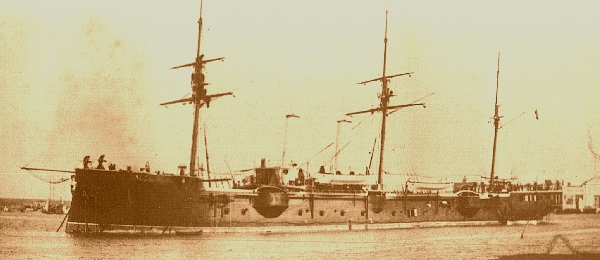


When Richmond Hobson of the U.S. Navy attempted to sink the collier USS MERRIMAC in the channel leading into the harbor to bottle up the Spanish fleet, the REINA MERCEDES was involved in the bombardment of the American vessel.
On the June 6, 1898 bombardment of Santiago, the REINA MERCEDES received thirty-five hits, though protected by the hills near the harbor entrance. Two of the shells started fires, including a particularly bad fire in the forward paint locker. While directing the fire fighting actions, Commander Emilio Acosta y Eyermann was hit by a shell which took off his right leg at the hip and his right hand, horribly mutilating him. He said "This is nothing.....Viva Espana!" before he died. Acosta y Eyermann became the first Spanish Naval officer to die in the War.
Later,
with the loss of the Spanish Fleet, and the removal of six Bustamente
torpedos which were protecting the harbor entrance to permit the
attempted escape of the fleet, the approach to Santiago was considered
to be under-protected. To block the harbor, the order was given to sink
the cruiser REINA MERCEDES across the channel.
Quickly, the ship was readied for its mission. At 8:00 pm on July 5, she made her attempt, with her commander, Ensign Nardiz, several engineers and sailors, and Pilots Apolonio Nunez and Miguel Lopez serving as a crew. Her bow anchors and the stern spring cable were made ready to anchor the ship in the proper location.
About Midnight, on July 5, 1898, the REINA MERCEDES was spotted in the searchlight of the USS MASSACHUSETTS as it was coming out of Santiago Harbor. The USS MASSACHUSETTS and the USS TEXAS opened a continuous fire on her. The vessel sunk, however it is not clear if she was scuttled or sunk by the fire from the American vessels. Regardless, she sunk in the location selected, however, a projectile cut the spring on the stern spring cable, and the ship drifted. As a result, the ship was sunk on the edge of the channel and did not block it.
The Spanish were of the impression that the ship was too
badly damaged for the Americans to refloat and reuse the vessel, and had
considered it a minor victory in that they had kept the
projectile-ridden vessel from falling into American hands. However,
efforts to raise the vessel began on January 2, 1899, and were completed
by March 1. She was towed to Norfolk Navy Yard, and then to Portsmouth
Navy Yard, Kittery, Maine, arriving there on August 25, 1900 for
refitting.
Efforts to make the vessel into a training ship failed, and the REINA
MERCEDES became a non-selfpropelled receiving ship. She was towed to
Newport, R.I. in 1905 where she was placed near the USS CONSTELLATION.
She remained there until 1912, except for a visit to Boston and New York
in 1908. In 1912, the vessel was towed to Norfolk Navy Yard, and
overhauled for use as a station ship at Annapolis, where she remained
until being struck from the Navy rolls in 1957. At Annapolis, she was
designated the IX-25. When the Spanish battleship ALFONSO XIII visited
Annapolis in 1920, the REINA MERCEDES again flew the Spanish flag as
a gesture of friendship. Until 1940, midshipmen were punished by having
to live aboard the vessel for up to two months at a time, though she
never was actually used as a brig. After 1940, she served as living
quarters for enlisted men assigned to Naval Academy, and for the
Commander of the Naval Station. The Commander was provided with quarters
for his entire family, so the REINA MERCEDES was the only U.S. vessel on
which dependents were permitted to live.
The vessel left Annapolis only for refitting in 1916, 1927, 1932, 1939, and 1951. She was again sent for refitting in 1957, but the costs were considered to be too high to warrant the completion of the work. The REINA MERCEDES was decommissioned on November 6, 1957 and sold to the Boston Metals Co., on Baltmore, MD for scrapping.
| Classification: | Unprotected Cruiser (U.S. designation IX-25) | |
|---|---|---|
| Launched: | September 12, 1887 | |
| Rig: | Three masts, two fully rigged, one schooner rigged. | |
| Armament: | Six 16 cm (6.3 inch) Hontoria guns, four of which had been | |
| removed and used in the defenses of Santiago Harbor. | ||
| 2 guns of approximately 7 to 10 cm | ||
| 10 rapid fire guns | ||
| Whitehead Torpedos | ||
| Length: | 280 feet | |
| Beam: | 43 feet, 3 inches | |
| Mean draft: | 21 feet, 11 inches | |
| Displacement: | 2,835 tons | |
| Speed: | 9 knots | |
| Armor: | None |
Clerk of Joint Committee on Printing, The Abridgement of Message from the President of the United States to the Two Houses of Congress, (Washington: Government Printing Office, 1899. Vols. 2, 4.
Iborra Abargues, Federico (provided image of sunken REINA MERCEDES).
Jane, Fred D., Janes All the World's Fighting Ships, 1898, New York: Arco Publishing Co., Inc, 1969.
Jeffers, H. Paul, Colonel Roosevelt: Theodore Roosevelt Goes to War, 1897-1898. (New York: John Wiley & Sons, Inc., 1996).